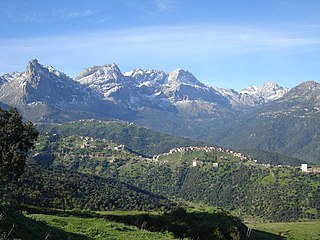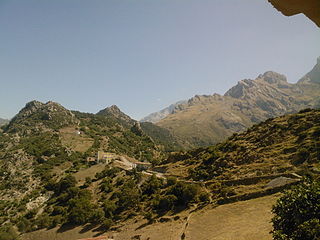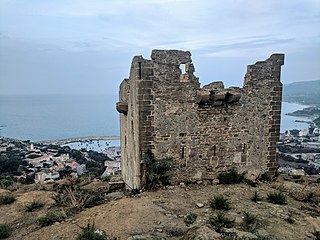
Kabylia or Kabylie is a mountainous coastal region in northern Algeria and the homeland of the Kabyle people. It is part of the Tell Atlas mountain range and is located at the edge of the Mediterranean Sea.

Boumerdès is a province (wilaya) of northern Algeria, located in the Kabylia region, between Algiers and Tizi-Ouzou, with its capital at the coastal city of Boumerdès just east of Algiers.

Tizi Ouzou is a province (wilayah) of Algeria in the Kabylia region. Its capital is Tizi Ouzou, with a popoluation of 1.198.561 inhabitants in 2019, with a density of 405/square kilometers.

Lalla Fatma N'Soumer was an Algerian anti-colonial leader during 1849–1857 of the French conquest of Algeria and subsequent Pacification of Algeria. She led several battles against the French forces, until her capture in July 1857. She was imprisoned until her death six years later. She is an Algerian national hero.

Larbaâ Nath Irathen is a town in Tizi Ouzou Province, in the central part of northern Algeria. It was formerly known as Fort National. The population in 2002 was 29,773, The area is renowned for its majestic scenery.

The Kabyle people are a Berber ethnic group indigenous to Kabylia in the north of Algeria, spread across the Atlas Mountains, 160 kilometres (100 mi) east of Algiers. They represent the largest Berber population of Algeria and the second largest in North Africa.

The French conquest of Algeria took place between 1830 and 1903. In 1827, an argument between Hussein Dey, the ruler of the Regency of Algiers, and the French consul escalated into a blockade, following which the July Monarchy of France invaded and quickly seized Algiers in 1830, and seized other coastal communities. Amid internal political strife in France, decisions were repeatedly taken to retain control of the territory, and additional military forces were brought in over the following years to quell resistance in the interior of the country.

Hocine Aït Ahmed Stadium is a football stadium located in Boukhalfa, Tizi Ouzou, Kabylia region, Algeria. Hocine Aït Ahmed Stadium is owned by the Algerian Ministry of Youth and Sport. With 50,766 seats, it is the third largest stadium in Algeria. The stadium was designed by United States-based construction company Atlas Group subsidiary Atlas Genie Civil Spa they completed the project in 2023 after 13 years of work as they started the construction on May 15, 2010. Replacing the 1 November 1954 Stadium, it is the new home ground of JS Kabylie, since 2024.

Aït Yahia is a commune in the Tizi Ouzou wilaya in northern Algeria, located 47 km to the southeast of Tizi Ouzou, 33 km to the south of Azazga, and 4 km northeast of Aïn El Hammam. The administrative center of the commune is the village of Ait Hichem [fr].

Bou-Nouh is a town and commune in Tizi Ouzou Province in northern Algeria.

Aït Irane, ath yirane ⴰⵉⵜ ⵉⵔⴰⵏⴻ in Tifinagh, means izmawen, is one of the villages of the Aït Bouadou commune, also called Ath Vouvaddou or Beni Bouaddou. Aït Bouadou is a commune of the Ouadhia District (daïra) which is a Tizi Ouzou Province (wilaya) in the Kabylie region of Algeria.

The Larbaâ Nath Irathen is an Algerian administrative district in the Tizi-Ouzou province and the region of Kabylie. Its chief town is located on the common namesake of Larbaâ Nath Irathen.
Ali Yahia Abdennour was an Algerian politician, lawyer and human rights activist.
The Socialist Forces Front rebellion in Algeria took place in the Kabylia region of northern Algeria by the Socialist Forces Front (FFS) rebelling against the Algerian government under the National Liberation Front (FLN). The rebellion was swiftly defeated by Algerian government forces and its leader Hocine Aït Ahmed was arrested.
Imezdaten is a village in Kabylia located 15 km southwest of Tizi Ouzou in the Betrouna region and municipality of Tizi Ouzou, Algeria.

The Battle of the Col des Beni Aïcha (1846) or Battle of Thénia (1846), which broke out on 3 February 1846, was a battle of the French conquest of Algeria between the Algerian rebels, and the France, which was the colonial power in the region since 1830.

The Second Assault of Dellys was an assault by French troupes coloniales under General Thomas Robert Bugeaud (1784–1849) against the Algerian resistance fighters in the town of Dellys, Kabylia of the Igawawen. It was part of the French conquest of Algeria and took place in April–May 1844.

The 2021 Algeria wildfires were multiple wildfires that happened in the Kabylia region of Algeria since 9 August 2021, which have killed 90 people, including 57 civilians and 33 soldiers. The soldiers died after being trapped in the blaze during rescue operations.
The Battle of Tadmaït took place between the Emirate Of Mascara against the French Army.

Rajaouna Mountain is a peak in the Djurdjura mountain range in the Tell Atlas in Algeria, located in the Tizi Ouzou, Tizi Ouzou District, Tizi Ouzou Province of the Kabylia region of Algeria.















